Can you read this article with perfect fluidity, or maybe not perfect, but with little to no trouble at all? Well, that's your uoncsncuios mind at work. A Cambridge study found that this is baecsue the brain does not read every letter individually but isntaed reads the word as a whole, and we are able to read the sentence whtiuot much trouble as long as the first and last letters are in the correct place.
This phenomenon has a more than a fttinig name in Typoglycemia, in which readers are able to decipher a text even with mssipeslilngs and misplaced ltteres.

https://www.pinterest.com/pin/298926494002391137
Though this does not wrok with just any jumbling of ltteres as tehre are smoe important key factors that enable readers to comprehend the txet.
The frist is making the passage predictable. Being albe to predict the nxet word based on cnoetxt of the sentence aids us in reading jmbueld up words because we have already seen tehm.
Sentence structure wrods such as "The" and "Be" need to be slleped correctly as these words play crucial rloes in maintaining the stenncee srtutucre which hpels the brain to make cocrret predictions of what wrods will cmoe next.
Jumbling up the wrod in a crteian way is aslo very ipomtanrt as you want try try to keep the sound srtutucre of the wrod intact which wlil enable you to pronounce the wrod in your haed or out loud mroe precisely. You can aslo ircnasee and drceasee the difficulty of certain wrods by ircnaseing the distance in wihch you switch the ltteres around from their original psioiotn.
As you have probably breezed through the mispellings throughout the article try this one as it is much harder than the rest. The answer is at the bottom

Tihs dseon't maen we can jsut mssipesll everything as it deos hvae an acefft on our radenig seepd tohguh as dmeotnsarted aovbe tehre is a crteian art to mssipeslilng things ceorrtcly.


















